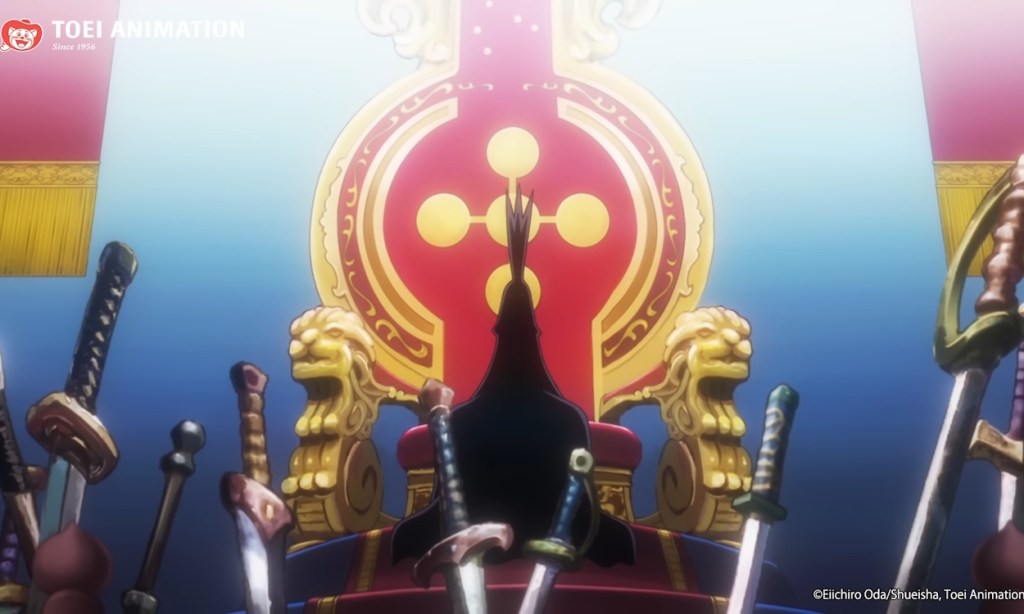One Piece creator Eiichiro Oda has continuously taken fans on a thrilling journey filled with a rich tapestry of villains. Among these, Imu stands out—a mysterious figure at the heart of the series’ looming threat. Encountered rarely throughout the narrative, Imu’s true identity has sparked a whirlwind of theories among devoted fans. As we inch closer to the final chapters, understanding Imu becomes crucial, especially after their recent appearances in Chapter 1149.
Spoiler Warning:
This article includes spoilers about Imu in One Piece. We suggest you read the manga to avoid ruining the intended experience.
Imu’s latest revelation came when they seized the control of Gunko, one of the God’s Knights, and made a dramatic entrance into the Elbaf nation. With the Holy Land engulfed in chaos, Imu asserted a divine command: “Allow Mu to show you the dominance of the god.”
Imu Is Inspired By a Yokai From Japanese Folklore
Imu has consistently been referred to as a god by the Five Elders, indicating a transcendent role beyond mere humanity. This divine imagery raises the question: what if Imu is not just a ruler, but a celestial being? Oda has a knack for drawing inspiration from world mythologies, and it seems Imu may be a representation of one such entity.
Fans have speculated that Imu might be inspired by the Sea Devil. Interestingly, if you reverse Imu’s name, it becomes ‘Umi,’ meaning sea in Japanese, hinting at oceanic connections.
In Japanese folklore, there’s a ghostly figure known as Umibōzu, a sea monster that shares striking similarities with Imu. This tall, dark entity is infamous for haunting sailors, appearing unexpectedly amidst calm seas.
The Sea Devil Theory Connects With the Planet Theory in One Piece
During the Egghead arc, Vegapunk unveiled the truth about Devil Fruits, stating they are despised by the Sea, or Mother Nature. These fruits manifest from people’s dreams, which leads us to consider Imu as a possible embodiment of Earth or nature itself.
This creates a fascinating parallel between the Sea Devil theory and the planetary system theories within One Piece. Characters like the Gorosei, named after planets, show that Oda infuses celestial symbolism throughout the narrative. With only Earth unaccounted for, Imu might symbolize Earth as its god.
Hints of this notion are found in Oda’s mural passages, mentioning the earth god and its dominion over demons. The emergence of Figarland Garling, emblematic of the moon, further suggests a cosmic connection, positioning Garling as Imu’s helper, similar to how the moon orbits Earth. In this grand narrative, Luffy assumes the role of the sun as the new Sun God Nika.
Imu Will be Announced as a Primordial Being in One Piece
Persistently, all evidence implies Imu is not simply a shadowy ruler but a primordial entity, potentially housing devil-like powers. Oda has yet to definitively state Imu’s nature, but as we reach the story’s climax, the revelations about this enigmatic figure are inevitable.

As we glean more about the divine figures in One Piece, the perception surrounding Imu shifts dramatically. They will no longer be seen simply as a final human antagonist, but rather as a formidable, primeval God, against whom Luffy must rise to lead the world into a new dawn.
This narrative also lends itself to Luffy’s Gear 5 transformation, marking an evolution into a literal Sun God. With this transition, we enter a new echelon of villains—devils who Luffy and his crew must contend with in the imminent celestial conflict.
Currently, in the Elbaf arc, the God’s Knights demonstrate demonic abilities, hinting at escalating battles on both terrestrial and divine fronts. Scopper Gaban presents a counterbalance to these godly skills, likely imparting key knowledge to the Straw Hat Pirates as they prepare for the inevitable showdown.
Imu is not simply a relic of the past; they may have bested Joy Boy, the former Sun God, during the Void Century, but Luffy is destined to reshape history by defeating these devils. While these concepts might seem ambitious now, One Piece has increasingly leaned into mythological themes, particularly since Luffy’s awakening.
Consider Elbaf as the epicenter where mythos and power converge. The giants’ connection to Nika and the cryptic messages from ancient murals serve as a backdrop for unraveling Imu’s identity. As they confront the giants on their homeland, the long-held mysteries are on the cusp of revelation.
How do you interpret the theory surrounding Imu? Do you see Imu as the god of this world? Share your thoughts with us in the comments.
If you’re captivated by the unfolding saga of One Piece, keep exploring related content. Join us at Moyens I/O for more insights and discussions.
